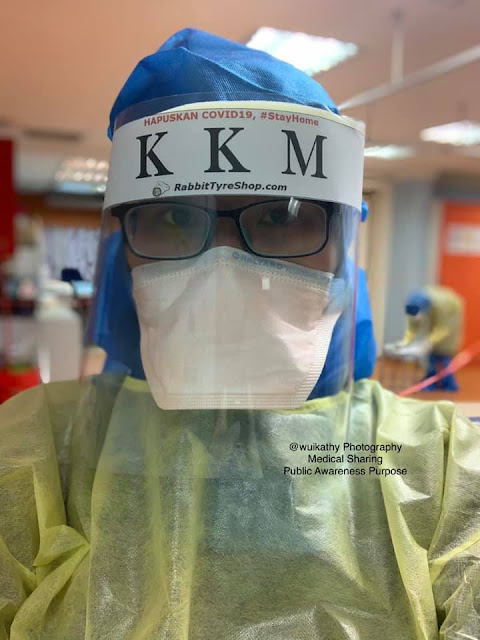COVID-19
COVID-19
pandemic is something that many did not “see it coming”. Coronavirus disease
(COVID-19) is an infectious disease caused by a newly discovered coronavirus.
The
COVID-19 virus spreads primarily through droplets of saliva or discharge from
the nose when an infected person coughs or sneezes. Therefore, it is important
to practice respiratory etiquette (e.g. coughing into a flexed elbow). Most
people infected with the COVID-19 virus will experience mild to moderate
respiratory illness and recover without requiring special treatment.
Older
people, and those with underlying medical problems like cardiovascular disease,
diabetes, chronic respiratory disease, and cancer are more likely to develop
serious illness. The best way to prevent and reduce transmission is to be well
informed about the COVID-19 virus, the causes of the disease and the mode of
spread.
IN PREPARATION OF COVID-19 PANDEMIC
In the Department
of Biomedical Imaging, University of Malaya Medical Centre, Kuala Lumpur, a
Task Force COVID-19 team was formed to plan, prepare and manage the new
challenges and to ensure smooth delivery of imaging services.
The staff were divided into two teams in anticipation of
accidental exposures to COVID-19 patients. This was necessary to ensure the
service delivery was not interrupted, should the need arise for staff to
undergo quarantine process.

As one of the
front liner team, the Radiographers are required to screen and scan body
temperature of each patients prior to imaging examinations such as X-Ray, CT
Scan, MRI and other examinations.
Radiographers carrying out mobile radiography
play an important role in performing bedside imaging (e.g. chest X-Ray) at the
designated wards and emergency areas. The request for mobile radiography
increased during the pandemic as to avoid risk exposure to staff during patient
transfer to the imaging department.
Prior to the mobile examination, the
equipment (tube head and arm only) is covered with plastic, especially when
handling patient on high flow mask / intubated / nebulizer. The image receptor
(e.g. Imaging Plate (IP) / digital detector) will be wrapped with zip lock
plastic and into another plastic bag to ensure double protection. The equipment
is then cleaned using disinfectant.
Should
the COVID-19 patient have other diseases, such as Diabetes Mellitus and
cardiovascular disease, they are most likely to develop other complications
that may require CT Scan or MRI imaging for diagnosis and treatment purposes.
Therefore, several stimulation sessions on donning and doffing Personal
Protective Equipment (PPE) and handling of COVID-19 patients were conducted in
clinical areas so that staff are aware and well informed in managing the new
challenges.
PERSONAL PROTECTIVE EQUIPMENT (PPE)
Generally,
when handling routine patients, donning personal protective equipment (PPE)
such as surgical face mask, disposable glove (when handling bodily fluid) and
practising hand hygiene based on the opportunities and indications should be
suffice.
When
performing imaging examination for patient under surveillance (PUS), PPE such
as, surgical face mask / N95 [for aerosols generating procedure (AGP)], face
shield / eye protection, isolation gown (fluid-repellent long-sleeved gown) and
non-sterile gloves are donned.
When
handling patient under investigation (PUI) or COVID-19 patient, full PPE
(listed as for PUS patients with additional PPE such as head cover, shoe cover
and scrub suit for AGP patients) are donned.
Surgical face mask is replaced
with N95 mask if patient is unable to wear mask, coughing, requires oxygen
support or ventilated. Therefore, it is paramount to be aware and be informed
of the patient’s condition so that radiographers can protect themselves when performing
their duties.
STANDARD OPERATING PROCEDURE (SOP)
It is
essential for radiographers to adhere to the new Standard Operating Procedure
(SOP) to avoid accidental exposures. After handling COVID-19 patients, the
radiographer will perform disinfectant cleaning (on the equipment used) and
shower. The room will be decontaminated (by external providers) before
proceeding with the next patient for examination.
With the additional
requirements, ensuring adequate staffing is important to ensure smooth flow of
the imaging services rendered and this was ensured by the Task Force COVID-19
team.
THE IMPORTANCE OF HANDWASHING AND COMPLIANCE TO HAND
HYGIENE
We would like
to emphasize the important of handwashing and / or hand rub technique. Protect
yourself and others from infection by practising proper hand washing with soap
and water / using alcohol-based hand rub frequently and avoid touching your
face.
THE NEW NORMAL
New protocol, New
strategy, Handling Patients, New Guidelines and Teamwork (e.g. Radiologist,
Radiographer, Nurses, Attendants and other staff). Together we perform our
roles and responsibilities efficiently to face this new challenge, COVID-19.
We are happy to see all staff of UMMC and
community in their relentless fight against COVID-19!
Together,
We
can Win the Fight Against COVID-19!
#KitaTeguhKitaMenang #KitaJagaKita #MalaysiaPrihatin #StayAtHome #StayHealth #StaySafe #StayCare
The New Normal!
3Cs: Avoid Crowds
| Contact | Confined Spaces
3Ws: Wear Masks |
Wash Hands and Sanitize | Warn Others to Practise SOP
ACKNOWLEDGEMENT
We would like to
thank and appreciate donations of essential items from all generous
contributors to the department and University of Malaya Medical Centre (UMMC)
in support of the challenging situation. #KitaJagaKita
Happy World Radiography Day 2020 to all Medical Radiographers! #WRD2020
ARTICLE BY UMMC RADIOGRAPHERS
Kathy Wui Ai Leng, MRI COVID-19 Team
Siti Nur Aisyah Binti Zolkaplie, COVID-19
Task Force Team
Mohd Zukhairi Bin Che Romly, COVID-19 Task
Force Team
Ravi Chanthriga Eturajulu (Officer), COVID-19
Task Force Team
REFERENCES:
World Health Organization, https://www.who.int/health-topics/coronavirus#tab=tab_1
University Malaya Medical Centre SOP, https://www.ummc.edu.my/
University Malaya Medical Centre Task Force
Team
For more about Mouse Mommy Treats,
do follow us*























































